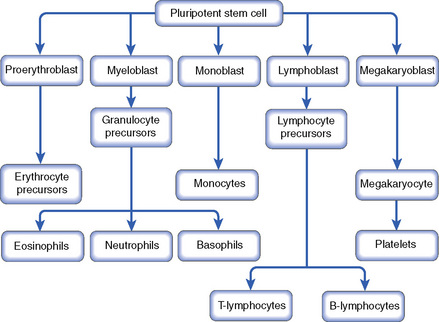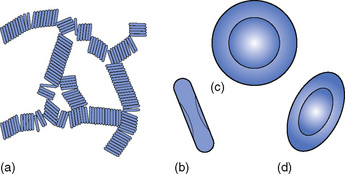13 The blood
Composition of the blood
Plasma
The blood cells
The formation of blood cells
The formation of blood cells takes place in the bone marrow and the mature products are released into the blood stream. Eight different cells are formed and all are formed from one type of pluripotent stem cell, which gives rise to five different lines of cells (Fig. 13.1). The myeloblast line gives rise to three types of granulocyte cells and the monoblast and lymphoblast lines give rise to the agranulocyte cells. The erythrocytes (red cells) and the platelets are formed from their own specific cell lines.
Red cells
The red cells (erythrocytes) are disc-shaped bodies, concave on both sides (Fig. 13.2). They are very numerous, numbering about 5 000 000 per cubic millimetre (mm3) of blood. They have a diameter of 7.2 micrometres (1 micrometre = 1/1000 mm, abbreviated to μm). They have no nucleus but contain a special protein known as haemoglobin. This is a yellow pigment but the massed effect of these numerous yellow bodies is to make the blood appear red. Haemoglobin contains a little iron, which is essential to normal health, though the total amount in the whole body is said to be only sufficient to make a 5-cm (2-in) nail. Haemoglobin has a great affinity for oxygen. As the red cells pass though the lungs the haemoglobin combines with oxygen from the air (forming oxyhaemoglobin) and becomes bright in colour – this makes the oxygenated blood bright red. As the red cells pass through the tissues oxygen is given off from the blood and the haemoglobin becomes a dull colour (reduced haemoglobin), making the blood a dark purplish-red. The haemoglobin is measured in grams per 100 mL; the normal figure is 14–16 g/100 mL.
< div class='tao-gold-member'>
Stay updated, free articles. Join our Telegram channel

Full access? Get Clinical Tree




